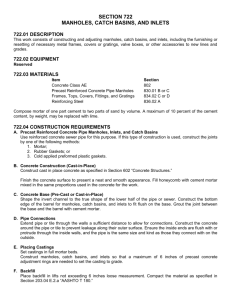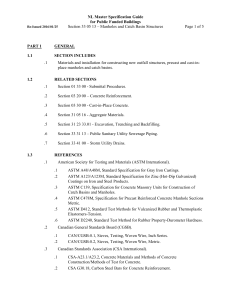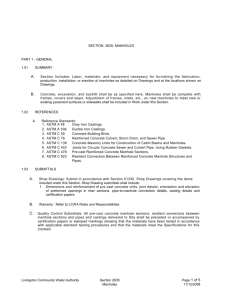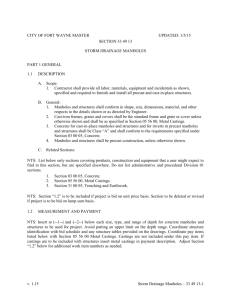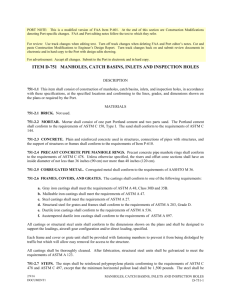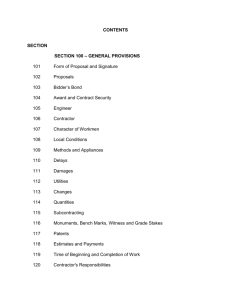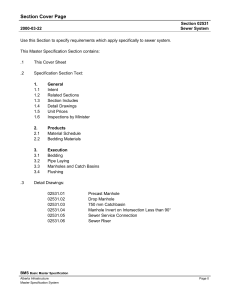2.01 precast concrete manholes
advertisement
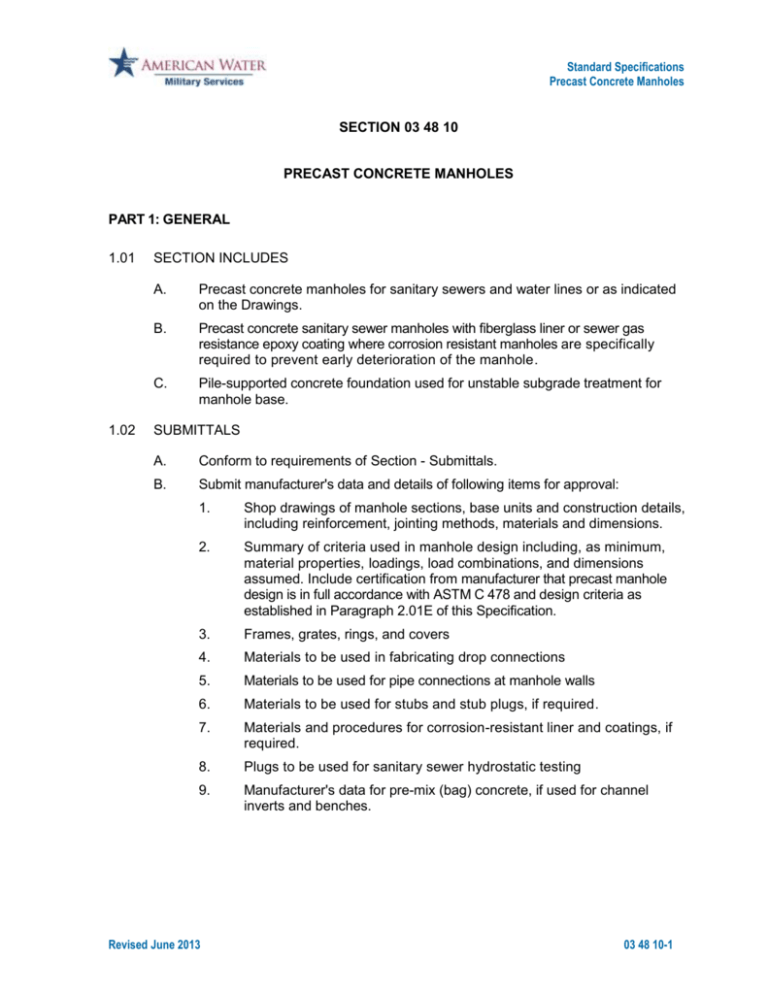
Standard Specifications Precast Concrete Manholes SECTION 03 48 10 PRECAST CONCRETE MANHOLES PART 1: GENERAL 1.01 1.02 SECTION INCLUDES A. Precast concrete manholes for sanitary sewers and water lines or as indicated on the Drawings. B. Precast concrete sanitary sewer manholes with fiberglass liner or sewer gas resistance epoxy coating where corrosion resistant manholes are specifically required to prevent early deterioration of the manhole. C. Pile-supported concrete foundation used for unstable subgrade treatment for manhole base. SUBMITTALS A. Conform to requirements of Section - Submittals. B. Submit manufacturer's data and details of following items for approval: 1. Shop drawings of manhole sections, base units and construction details, including reinforcement, jointing methods, materials and dimensions. 2. Summary of criteria used in manhole design including, as minimum, material properties, loadings, load combinations, and dimensions assumed. Include certification from manufacturer that precast manhole design is in full accordance with ASTM C 478 and design criteria as established in Paragraph 2.01E of this Specification. 3. Frames, grates, rings, and covers 4. Materials to be used in fabricating drop connections 5. Materials to be used for pipe connections at manhole walls 6. Materials to be used for stubs and stub plugs, if required. 7. Materials and procedures for corrosion-resistant liner and coatings, if required. 8. Plugs to be used for sanitary sewer hydrostatic testing 9. Manufacturer's data for pre-mix (bag) concrete, if used for channel inverts and benches. Revised June 2013 03 48 10-1 Standard Specifications Precast Concrete Manholes PART 2: PRODUCTS 2.01 2.02 PRECAST CONCRETE MANHOLES A. Provide manhole sections, base sections, and related components conforming to ASTM C 478. Provide base riser section with integral floors, unless shown otherwise. Provide adjustment rings which are standard components of manufacturer of manhole sections. Mark date of manufacture and name or trademark of manufacturer on inside of barrel. B. Construct barrels for precast manholes from standard reinforced concrete manhole sections of diameter indicated on AW Standard Drawings. Use various lengths of manhole sections in combination to provide correct height with fewest joints. C. Provide tops to support AASHTO HS-20 vehicle loading, and receive cast iron frame covers, as indicated on AW Standard Drawings. D. For manholes larger than 48-inch diameter, provide precast base sections with flat slab top precast sections used to transition to 48-inch diameter manhole access riser sections. Transition can be concentric or eccentric unless otherwise requested by AW Project Manager. Locate transition to provide minimum of 7-foot head clearance from base to underside of transition unless otherwise approved by AW Project Manager. E. Design Loading Criteria: Manhole walls, transition slabs, cone tops, and manhole base slab shall be designed by manufacturer, to requirements of ASTM C 478 for depth as shown on AW Standard Drawings and to resist the following loads. 1. AASHTO HS-20 vehicle loading applied to manhole cover and transmitted down to transition and base slabs 2. Unit soil weight of 120 lbs/ft3 located above portions of manhole, including base slab projections 3. Lateral soil pressure based on saturated soil conditions producing an atrest equivalent fluid pressure of 100 lbs/ft3 4. Internal liquid pressure based on unit weight of 63 lbs/ft3 5. Dead load of manhole sections fully supported by transition and base slabs F. Provide joints between sections with o-ring gaskets conforming to ASTM C443. G. When base is cast monolithic with portion of vertical section, extend reinforcing in vertical section into base. H. Precast Concrete Base: Suitable cutouts or holes to receive pipe and connections. Lowest edge of holes or cutouts: For water line manhole, no less than 6-inches above inside surface of floor of base. CONCRETE A. Conform to requirements of Section - Cast-In-Place Concrete. Revised June 2013 03 48 10-2 Standard Specifications Precast Concrete Manholes 2.03 B. Channel Inverts: Use concrete for inverts not integrally formed with manhole base, with minimum compressive strength of 4000 psi. C. Concrete Foundation: Provide concrete with minimum compressive strength of 4000 psi for concrete foundation slab under manhole base section as indicated on AW Standard Drawing. REINFORCING BARS A. 2.04 2.05 FRAMES AND COVERS A. Use castings for frames, grates, rings and covers conforming to ASTM A48, Class 35B. B. Use clean castings capable of withstanding application of AASHTO M30640,000 pound proof loading without detrimental permanent deformation. C. Fabricate castings to conform to shapes and dimensions as shown on AW Standard Drawing, and cast with the wording or logo “SEWER”for sanitary sewer and “WATER” for water system frames and covers. Standard dimensions for manhole frames and covers shall be either 24 or 30-inches in diameter. D. Castings shall be smoooth and clean, and free from blowholes and other surface imperfections. Use clean and symmetrical cast holes in covers, free of plugs. E. Provide watertight manhole frames and covers when the top of the frame and cover is below the 100-year flood elevation or when subjected to ponding. Watertight manhole frames and covers shall be provided with minimum of four bolts and gasket designed to seal cover to frame. Supply approved watertight manhole covers and frames. DROP CONNECTIONS AND STUBS A. 2.06 Conform to the requirements of Section – Cast-In-Place Concrete. All manhole drop connections shall be outside drop. Outside drops shall be provided when the invert elevation into the manhole is 24-inches higher than the manhole invert. 1. Pipe material used for outside drops shall be same pipe material as sewer main, or; 2. Ductile iron pipe as indicated on AW Standard Detail. PIPE CONNECTIONS TO MANHOLE A. Sanitary Sewers. 1. Provide resilient connectors conforming to requirements of ASTM C923. Use the following materials for metallic mechanical devices as defined in ASTM C923: a. External clamps: Type 304 stainless steel Revised June 2013 03 48 10-3 Standard Specifications Precast Concrete Manholes 1) Internal, expandable clamps on standard manholes: Type 304 stainless steel, 11 gauge minimum. 2) Internal, expandable clamps on corrosion-resistant manholes: b. Type 316 stainless steel, 11 gauge minimum c. Type 304 stainless steel, 11 gauge minimum, coated with minimum 16 mil fusion bonded epoxy conforming to AWWA C213 2. B. 2.07 Where smooth exterior pipes, i.e., steel, ductile iron, or PVC pipes are connected to manhole base or barrel, seal space between pipe and manhole wall with assembly consisting of rubber gasket or links mechanically compressed to form a watertight barrier. 2. When connecting concrete or cement mortar coated steel pipes, or as option for connecting smooth exterior pipes to manhole base or barrel, space between pipe and manhole wall may be sealed with an assembly consisting of a stainless steel power sleeve, stainless steel take-up clamp and a rubber gasket. Take-up clamp: Minimum of 9/16-inch wide. Provide sealing materials between precast concrete adjustment ring and manhole cover frame in accordance with ASTM C443. Where corrosion-resistant manholes are required, such as a manhole receiving a force main or manholes located within a 1,000 feet down-stream of a force discharge, provide a fiberglass liner or sewer gas resistant epoxy coating for precast cylindrical manhole section, base sections, and cone sections. Liners relying on mechanically fastened batten strips as primary means of anchorage are unacceptable. All manholes with a corrosion resistant interior coating shall be provided with an exterior bituminous coating in locations where ground water table can reach above the base of the manhole. BACKFILL MATERIALS A. 2.10 1. CORROSION RESISTANT MANHOLE MATERIALS A. 2.09 Water Lines SEALANT MATERIALS A. 2.08 Where rigid joints between pipe and cast-in-place manhole base are specified, provide polyethylene-isoprene water-stop meeting physical property requirements of ASTM C923. Conform to requirements of Section - Excavation and Backfill for Utilities. NON-SHRINK GROUT A. Provide prepackaged, inorganic, flowable, non-gas-liberating, non-metallic, cement-based grout requiring only addition of water. B. Meet requirements of ASTM C1107 and have a minimum 28-day compressive strength of 7000 psi. Revised June 2013 03 48 10-4 Standard Specifications Precast Concrete Manholes 2.11 2.12 VENT PIPES A. Provide an external vent pipe for manholes for every third manhole when three or more consecutive water tight frame and covers are installed. B. Vent opening to be located a minimum of 1 foot above 100 year flood plain. C. Buried Vent Pipes: Provide appropriate size PVC or DIP as indicated on the Drawings. D. Vent Outlet Assembly: Provide vent outlet assembly as shown on AW standard details. PROHIBITED MATERIALS A. 2.13 Do not use brick masonry for construction of sanitary sewer manholes, including adjustment of manholes to grade. Use only specified materials listed herein. MANHOLE LADDER FOR WATERLINE MANHOLES A. B. Manhole Ladder: Fiberglass with 300-lb rating at appropriate length; conform to requirements of OSHA. 1. Use components, including rungs, made of fiberglass, fabricated with nylon or aluminum rivets and/or epoxy. Apply non-skid coating to ladder rungs. Mount ladder using manufacturer's recommended hardware. 2. Fiberglass: Premium type polyester resin, reinforced with fiberglass; constructed to provide complete wetting of glass by resin; resistant to rot, fungi, bacterial growth and adverse effects of acids, alkalis and residential and industrial waste; yellow in color. Provide approved petroleum-based tape encapsulating bolts in access manhole. PART 3: EXECUTION 3.01 3.02 EXAMINATION A. Verify that lines and grades are correct. B. Obtain an adequate foundation for all manhole structures by removing and replacing unsuitable material with well-graded granular material, by tightening with coarse rock, or by such other means as provided for foundation preparation of the connected sewers, or as directed by the AW Project Manager. C. Dewater sufficiently to maintain the ground water level at or below the bottom of the manhole foundation prior to an during the placement of the foundation. D. Do not build manholes in ditches, swales, or drainage paths unless approved by AW Project Manager. PLACEMENT Revised June 2013 03 48 10-5 Standard Specifications Precast Concrete Manholes 3.03 3.04 3.05 A. Install precast manholes to conform to locations and dimensions as shown on Drawings. B. Place sanitary manholes at points of change in alignment, grade, size, pipe intersections, and end of sewer unless otherwise directed by AW Project Manager. MANHOLE BASE SECTIONS AND FOUNDATIONS A. Place precast base on 6-inch thick (minimum) foundation of crushed stone, or concrete foundation slab. B. Unstable Subgrade Treatment: Notify AW Project Manager immediately when unsatisfactory material is encountered in the manhole subgrade. With AW approval, up to 12-inches of additional undercut may be permitted to achieve suitable foundation. If the additional undercut does not result in a satisfactory foundation, the Contractor shall obtain a bedding design prepared by a Geotechnical Engineer licensed in the State in which the project is being constructed. PRECAST MANHOLE SECTIONS A. Install sections, joints, and gaskets in accordance with manufacturer's printed recommendations. B. Install precast adjustment rings above tops of cones or flat-top sections as required to adjust finished elevation and to support manhole frame. C. Seal any lifting holes with non-shrink grout. D. Where fiberglass liners are required, seal joints between sections in accordance with manufacturer's recommendations. E. Precast concrete grade rings shall be permitted to achieve the required grade. Grade rings shall not be permitted to more than 12-inches. F. External joint wrap all riser joints to ensure seal. No grout is permitted on the interior of manhole riser joints prior to testing. G. Concrete base must be dry prior to setting any sections above it. PIPE CONNECTIONS AT MANHOLES A. Install approved resilient connectors at each pipe entering and exiting manholes in accordance with manufacturer's instructions. 1. Where smooth exterior pipes, i.e. steel, ductile iron or PVC pipes are connected to manhole base or barrel, space between pipe and manhole wall shall be sealed with an assembly consisting of rubber gaskets or links mechanically compressed to form watertight barrier. 2. When connecting concrete or cement mortar coated steel pipes, or as an option for connecting smooth exterior pipes to manhole base or barrel, space between pipe and manhole wall may be sealed with an assembly consisting of stainless steel power sleeve, stainless steel take-up clamp and rubber gasket. Take-up clamp: Minimum of 9/16-inch wide. Revised June 2013 03 48 10-6 Standard Specifications Precast Concrete Manholes 3.06 B. Ensure no concrete, fill, or other rigid material is allowed to enter space between pipe and edge of wall opening at and around resilient connector on either interior or exterior of manhole. If necessary, fill space with compressible material to ensure full flexibility provided by resilient connector. C. Where new manhole is constructed on existing sewer, rigid joint pipe may be used. Install waterstop gasket around existing pipe at center of cast-in-place wall. Join ends of split waterstop material at pipe springline using an adhesive recommended and supplied by waterstop manufacturer. D. Test connection for watertight seal before backfilling, or at direction of AW. INVERTS FOR SANITARY SEWERS A. Construct invert channels to provide smooth flow transition waterway with no disruption of flow at pipe-manhole connections. Conform to following criteria: 1. Slope of invert bench: 1-inch per foot minimum; 1-1/2-inches per foot maximum 2. Depth of bench to invert: 3. a. Pipes smaller than 15-inches: one-half of largest pipe diameter b. Pipes 15 to 24-inches: three-fourths of largest pipe diameter c. Pipes larger than 24-inches: equal to largest pipe diameter Invert slope through manhole: 0.17 foot (2-inches) drop across manhole with smooth transition of invert through manhole, unless otherwise indicated on Drawing. Form invert channels with concrete if not integral with manhole base section. For direction changes of mains, construct channels tangent to mains with maximum possible radius of curvature. Provide curves for side inlets and smooth invert fillets for flow transition between pipe inverts. 3.07 3.08 DROP CONNECTIONS FOR SANITARY SEWERS A. Install drop connection when sewer line enters manhole higher than 24-inches above invert of manhole B. Backfill drop assembly shall be 3000 psi concrete to form solid encasement for all drop connections. Extend concrete encasement minimum of 4-inches outside bells, all per AW Standard Detail. STUBS FOR FUTURE CONNECTIONS A. 3.09 In manholes, where future connections are indicated on Drawings, install resilient connectors and pipe stubs with approved watertight plugs. MANHOLE FRAME AND ADJUSTMENT RINGS A. Combine precast concrete or HDPE adjustment rings so elevation of installed casting cover matches pavement surface. Seal between concrete adjustment ring and precast top section with non-shrink grout; do not use mortar between Revised June 2013 03 48 10-7 Standard Specifications Precast Concrete Manholes adjustment rings. Apply latex-based bonding agent to precast concrete surfaces joined with non-shrink grout. Set cast iron frame on adjustment ring in bed of approved sealant material. Install sealant bed consisting of two beads of sealant, each bead having minimum dimensions of 1/2-inch and 1/2-inch wide. 3.10 3.11 3.12 B. Wrap manhole frame and adjustment rings with external sealing material, minimum 3-inches beyond joint between ring and frame and adjustment rings and precast section. C. For manholes in unpaved areas, set top of frame flush with existing grade upto a maximum of 12-inches above existing grade, unless otherwise noted. In unpaved areas, encase manhole frame in mortar or non-shrink grout placed flush with face of manhole ring and top edge of frame. Provide rounded corner around perimeter. BACKFILL A. Place and compact backfill materials in area of excavation surrounding manholes in accordance with requirements of Section 31 23 33 - Excavation and Backfill for Utilities. B. Where rigid joints are used for connecting existing sewers to manhole, backfill existing sewer up to springline of pipe with flowable fill. C. In unpaved areas, provide positive drainage away from all manhole frames to natural grade. Provide restoration of disturbed areas in accordance with Section 32 92 00 – Lawn Restoration. DOGHOUSE MANHOLE A. Existing sewer pipe to remain until satisfactory completion of manhole testing. B. Crown of existing pipe shall be flush with concrete shelf that is formed within the manhole. C. Doghouse manholes shall be constructed as per AW Standard Details. FIELD QUALITY CONTROL A. 3.13 Conduct testing of manholes in accordance with requirements of Section 33 01 30.13 (Acceptance Testing for Sanitary Sewers). PROTECTION A. Protect manholes from damage until Work has been accepted. Repair damage to manholes at no additional cost to AW. END OF SECTION 03 48 10 Revised June 2013 03 48 10-8
